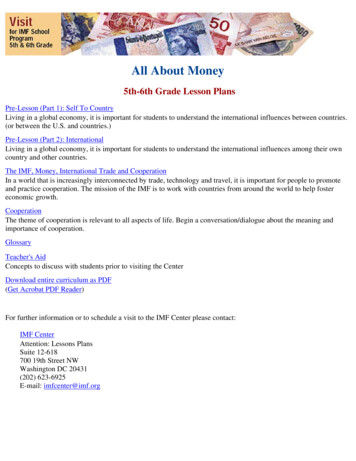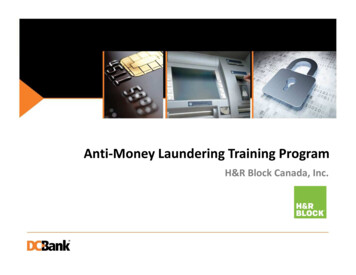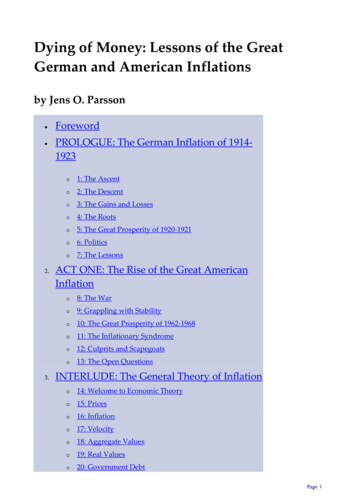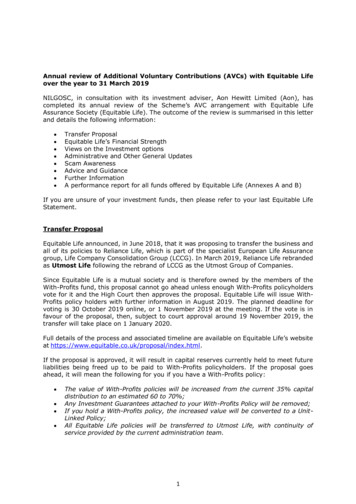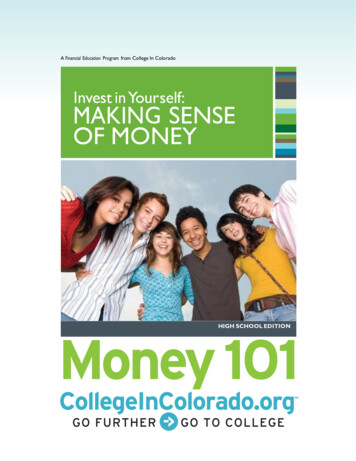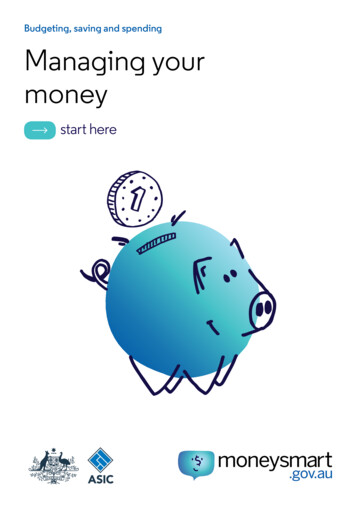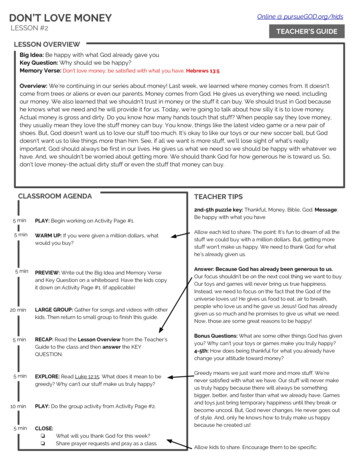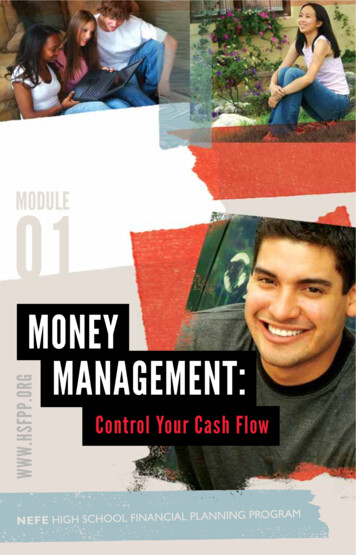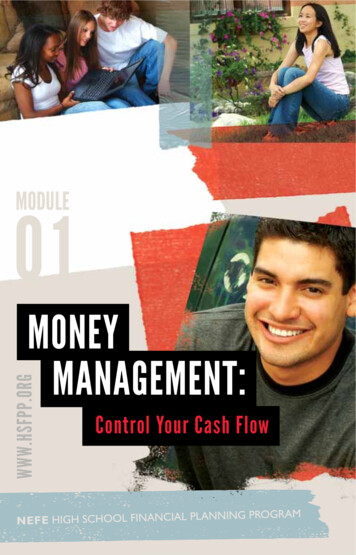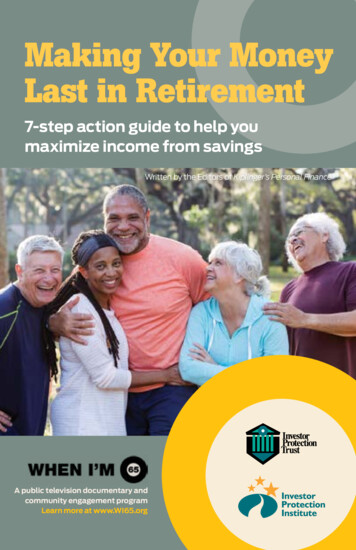
Transcription
Making Your MoneyLast in Retirement7-step action guide to help youmaximize income from savingsWritten by the Editors of Kiplinger’s Personal FinanceA public television documentary andcommunity engagement programLearn more at www.WI65.org
Create a SustainableMoney Plan7 STEPS YOU CAN TAKE TODAYWhether you’re fully retired or still working, you have many choices ahead,plus some important financial decisions to make. However you choose tospend your days—volunteering, launching a second act, or traveling the world—you’ll need to rely on a sustainable plan for your savings.The emphasis now will be to manage your finances so that you can achieve theretirement you want while also ensuring that your money goes the distance.Chances are, you’ll need those savings to stretch over 20 to 30 years, and yourplan going forward should reflect that time frame.Key strategies will include locking in sources of guaranteed income, preservingand protecting the savings you have, making the most of Medicare, and findingtrustworthy advisers to help you make the best choices for your situation.The good news? There are many opportunities for you to take charge of yourfinancial security today. That’s what this booklet is all about. It’s an action guidethat walks you through seven of the most important steps you can take now tohelp support your retirement years: Identify sources of income. Understand the rules for required minimum distributions (RMDs). Stay engaged in the workplace. Spend your savings safely. Manage Medicare wisely. Get trustworthy advice as you age. Consider your location.Now let’s take a closer look at the seven steps.2
STEP 1: I dentify sourcesof incomeWhen it comes to retirement income,most people gladly rely on SocialSecurity to provide a reliable “paycheck.”And some of us are lucky to also havepension income from another source.Beyond that, you’ll want to assess andmaximize as many sources of income aspossible. Here are several examples.Retirement savings include taxadvantaged accounts such as 401(k)sand individual retirement accounts,or IRAs. Once you reach age 70½, youmust begin taking required minimumdistributions under IRS rules (see STEP 2on RMDs) each year.Other income investments includeany nonretirement savings you have withbanks or brokerage firms (for example,money market accounts, mutual fundsor individual stocks and bonds). Theearnings in these accounts are taxed everyyear whether or not you withdraw funds.Reverse mortgages, or federallyinsured home equity conversionmortgage (HECM) loans, let you borrowagainst the equity in your home, butyou don’t have to repay the loan or theinterest on it until you leave the house.Set up as a line of credit, fixed monthlypayments, or a combination of the two,HECMs can be used to pay off debtsor cover living and medical expenses.However, fees and closing costs can besteep, and some loans may require fullpayback if you don’t live in your homefor more than a year—say, for a stay at acare facility.Annuities can work like self-fundedpension plans, offering a guaranteedincome stream. With an immediateannuity, you give an insurance companya lump sum and, in return, get backa guaranteed “paycheck” for either aspecific number of years or the restof your life. The pros are predictableincome and peace of mind. The consinclude overall costs, such as a salescommission and annual expenses. Plus,the purchase of an immediate annuityis generally irrevocable.An encore career or entrepreneurialpursuit also lets you keep one foot inthe workforce, so you can stay engagedas you continue to earn income.Adding roommates may be anotherway to offset high costs of homeownership while aging in place. If thisoption appeals to you, you’ll want tocheck state and local laws before yourent space in your home and notifyyour homeowners insurance companyto make sure you’re properly coveredagainst liability. TAKE-AWAY ACTION STEPS alk with an HECM counselor.TIf you’re interested in a reversemortgage, a government-approvedprofessional is required to meet withyou to explain terms and conditionsof any loan you’re considering. Find acounselor with the Federal HousingAdministration’s HECM counselorsearch tool, available at HUD.gov. Learn more about annuities’ prosand cons. See resources like these: “What Are Annuities?” US Securities& Exchange Commission, availableat Investor.gov “Annuities and Senior Citizens”Consumer Alert, National Associationof Insurance Commissioners,available at NAIC.org3
STEP 2: U nderstand therules for RMDsRequired minimum distributions areexactly what their name says. AnRMD is the minimum amount of moneyyou’re required by IRS rules to take outof your tax-deferred retirement plans(traditional IRA, 401(k), 403(b), and457(b) plans) every year once you turnage 70½.And beware: If you don’t take your fullRMD, the consequences are significant.You’ll be subject to a steep 50% taxpenalty on the amount you didn’t take!The dates: You generally have to takeyour first RMD by April 1 of the year afteryou turn 70½. For the years after that, youmust take RMDs by December 31. If youpush your first RMD to the year after youturn 70½, you’ll end up having to take,and pay tax on, two RMDs in one year.An example: Say you turned 70½in 2018 but put off taking the RMD untilMarch 2019. At that time, you’ll alsohave to withdraw the regular 2019 RMDand deal with a double tax burden.Two exceptions: Usually, you don’thave to take RMDs from your currentemployer’s 401(k) account until youleave that job. However, if you own morethan 5% of the company, you must starttaking RMDs at age 70½ even if you’restill on the job.And while you do have to take RMDsfrom Roth 401(k)s, you’re not required totake them from Roth IRAs. However, inboth cases, the withdrawals are tax-free.A note: Do separate RMDs apply formarried couples filing jointly? You andyour spouse must take RMDs separatelyfrom your own accounts even if you filea joint tax return. Pulling the RMD fromonly one spouse’s account will triggerIRS penalties.4A tax professional can guide youthrough the steps for calculating howmuch you’re required to withdraw, butyou can get a quick estimate usingthese tools:R equired Minimum DistributionWorksheets at IRS.gov.R equired Minimum DistributionCalculator for IRAs at Kiplinger.com.R equired Minimum DistributionCalculator for both 401(k)s andIRAs at Investor.gov.You can also read “FAQs AboutRMDs” on Kiplinger.com for moreinformation.PREPARE FOR QUARTERLYESTIMATED TAXPAYMENTSMost “income” that retirees receivewon’t have federal or state incometaxes withheld. That means you’llbe responsible for making quarterlyestimated tax payments throughoutthe year based on your expectedincome. That includes withdrawalsfrom traditional 401(k) or IRAaccounts, although withdrawals fromRoth accounts are always tax-free.Skipping these paymentsmay result in penalties andinterest that couldsignificantly increase your tax bill.Find detailed explanations and formsyou’ll need at IRS.gov and search“pay as you go so you won’t owe.”!
STEP 3: S tay engagedin the workplaceContinuing to work in some capacitycan be a key strategy for makingyour money last. In fact, nearly ninein 10 people say they expect workingfor pay to provide them with extraincome in retirement, according to a2018 survey by the Employee BenefitResearch Institute. Pre-retirees also saythey’ll choose to work in some capacitysimply to stay active and involved.Fortunately, there are manyresources you can tap to help discovera work opportunity that meets yourneeds. Here are three ideas to consider.CONSIDER THE GIG APPROACHAnyone can connect to the gigeconomy, thanks to online platformsthat link skilled providers withtemporary paid work.I f you speak a foreign languageor play a musical instrument,for example, find tutoringopportunities at TakeLessons.com.O r visit SideHusl.com forratings and reviews of morethan 250 gig opportunities, theirearning potential, and fees.AIM FOR NICHE JOB SITESTarget your search to organizationsthat cater to retirees. For example: The AARP Job Board at jobs.aarp.org matches interests andskills with employers that arecommitted to an age-diverseworkforce. YourEncore.com partnerswith nearly 90% of the toplife sciences and consumercompanies to recruit retireeswith scientific or technicalbackgrounds for short-term,flexible assignments. Encore.org, through its EncoreFellowships, matches skilled,experienced professionals whoare 50 with social purposeorganizations for high-impact,paid transitional positions.EXPLORE ENTREPRENEURSHIPOlder adults are a growing segmentof the US entrepreneurial population,and self-employment on your ownterms can provide greater flexibility.S BA.gov offers a freeonline course for “encoreentrepreneurs”—thosewanting to start a businessin retirement—search for “AnIntroduction to Starting YourOwn Business.”A nd free business mentoring andstartup education are availablefrom SCORE.org, a nationalnonprofit network of volunteerbusiness mentors who shareexpertise across 62 industries in320 US locations. TAKE-AWAY ACTION STEPF ind workforce tips, job advice, and employment services specificallygeared to older adults by visiting the US Department of Labor’sCareerOneStop.org.5
STEP 4: Spend yoursavings safelyOver the years, you’ve faithfully socked away as much aspossible in your retirement accounts and carefully chosenyour investments. Make the most of those savings by focusing onthree steps outlined below.CALCULATE A SAFE SPEND-DOWN PLANFiguring out how much of your nest egg you can afford to tap eachyear can be tricky, because there are so many unknowns—fromunexpected medical bills to unpredictable stock market returns.As a starting point, one rule of thumb that many financialexperts recommend is the “4% rule.” Using this strategy, youwithdraw 4% of total savings (including both retirement andnonretirement accounts) during the first year. Every dollar youwithdraw, including your RMDs, counts toward that 4%. Each yearthereafter, you increase that 4% slightly to account for inflation.Depending on your situation, 4% might feel like too much ortoo little. You can adjust the percentage every year, up or down,depending on the depth of your income sources and how wellyour investments perform.The key to the success of this recommendation: Don’t spendmore than your money earns. For example, if your portfolio earnsan average 3% return per year, withdrawing 4% may deplete ittoo quickly.USE A BUCKET STRATEGY FOR THE LONG HAULA bucket strategy divides your savings into three “buckets,” basedon a three-stage time horizon:Bucket 1 – Now. This bucket holds thecash you’ll need for livingexpenses over the next yearor two. You’re prioritizingsafety over earnings here,so the money in thisbucket will be stashedin an FDIC-insuredbank or money marketaccount (note: a moneymarket account thatyou open at a bank isdifferent from a moneymarket fund, which is aninvestment). The idea is that6
you’ll want easy access to this moneywhenever you need it. And as moneyflows in from your income sources, you’lldeposit it here.Bucket 2 – Soon. The secondbucket will generate reliable incomefrom relatively conservative sourcessuch as bonds, laddered bank CDs,high-performing money market funds,and blue-chip preferred stocks (ifyou’re willing to take a little risk). Thisbucket contains money you expect toneed in three to five years. If you ownan immediate annuity with guaranteedincome (see STEP 1), you may not needto hold as much money in this bucket.Bucket 3 – Later. Your third bucketcollects money you don’t expect to needfor at least five years. Here, the focus is ongrowth, so the bucket will include longterm investments such as stocks and realestate. You can take more financial risksin this bucket because there’s time forrecovery should any of the holdings losevalue.How the buckets work together.As you spend down your “Now” bucket,you’ll periodically replenish it from your“Soon” bucket, and refill that with fundsfrom your “Later” bucket. Practicallyspeaking, it’s easiest to maintainseparate accounts for your buckets; justmake sure that you can easily transfermoney from one bucket to anotherwithout a big lag or high fees.To implement the system on yourown, explore low-fee bond and fixedincome mutual funds or ETFs for your“Soon” bucket, and stick with broadmarket index funds for your “Later”bucket. Or, consider working with atrusted financial adviser (see STEP 6)to help plan the best approach.The bucket strategy’s strength isbuilt-in diversification. The focus onspecific asset classes in each bucketensures that you won’t be over-investedin any one type, which lowers risk.PRESERVE SAVINGS WITHTAX-SMART WITHDRAWALSIncome taxes come into play as you starttaking money out of your retirementaccounts. To minimize the inevitable taxbite, time withdrawals strategically byusing this three-part sequence.First, take all RMDs from retirementplans (traditional IRAs and 401(k),403(b), and 457(b) plans) to avoid thesteep IRS penalty. For traditional IRAs,you can pull the whole RMD from a singleaccount, but it must be based on the totalbalance of all your qualified accounts. Ifyou have several 401(k)s, however, youmust calculate and withdraw the RMDsseparately from each 401(k) account.Second, pull money from anytaxable accounts. Since you pay taxeson the earnings in regular savingsand investment accounts every yearanyway, it makes sense to withdrawfrom them next. That way, you won’tbe adding extra taxable income andincreasing your tax bill.Third, take any withdrawals (beyondRMDs) from tax-deferred and taxfree accounts (such as Roth IRAs)last. This allows your money the mostuninterrupted time to keep growing.Draw down these funds only whenthe combination of RMDs and taxableaccount withdrawals falls short of yourmonthly expenses.TAKE-AWAY ACTION STEPS ead “How to Implement the BucketRSystem” at Kiplinger.com. Check out the effect differentspend-down rates will have onyour portfolio with the RetirementWithdrawal Calculator, a free tool onthe American Institute for EconomicResearch website at AIER.org. Get specific guidance aboutretirement and taxes at IRS.gov/individuals/seniors-retirees.7
STEP 5: Manage MedicarewiselyEven if you’re already enrolled in Medicare, it’s important not to overlookthe annual opportunity to review coverage and change plans. Plus, if youor a spouse continued working after age 65 and still have health insurancethrough an employer, you may have delayed your Medicare signup. Let’s lookat the details of both situations.UNDERSTAND THE FUNDAMENTALSAs you know, basic Medicare coverage includes Part A (which covershospitalization and is premium-free for most people) and Part B (whichcovers doctor visits and outpatient services, and has a monthly premium).You are eligible to enroll in Medicare at age 65. If you’re already receivingSocial Security benefits, you’re enrolled in the premium-free Part Aautomatically.If you haven’t claimed Social Security benefits, enrollment in Medicareisn’t automatic. If neither you nor your spouse has employer health coverage,you should sign up for both Part A and Part B. Go to SSA.gov/Medicare toenroll three months before or after the month you turn 65—even if you aren’tsigning up for Social Security benefits.If you or your spouse is still working and you have employer coverage(COBRA coverage does not count), you may be able to delay signing up forMedicare Part B until your employer coverage ends. But beware: You mustenroll within eight months after this coverage ceases or you’ll face a lifetimepenalty in the form of a higher premium for Part B coverage. The penaltyamounts to 10% of the current Part B premium for every year you shouldhave been enrolled in Part B but were not!Your ability to delay also depends on your employer’s size. If your employerhas fewer than 20 employees, then Medicare typically becomes your primarycoverage at 65, and you generally need to sign up then to avoid coverage gaps.Once you enroll in Part B, you also have the option to add:M edigap (a supplemental policy for standard Medicare). If you buycoverage within six months of enrolling in Part B, you can get anyMedigap policy available in your area. After six months, Medigap insurerscan decline coverage or charge more because of pre-existing conditions.P art D prescription drug coverage.M edicare Advantage (Part C). Instead of getting Medigap and PartD coverage, you could get both your medical and prescription drugcoverage from a private insurer through a Medicare Advantage plan.EXERCISE YOUR RIGHT TO CHANGE COVERAGEEvery year, you have the opportunity to change, add, or drop coverage forPart D or Medicare Advantage plans during open enrollment season. Even ifyou’ve been happy with your plan, it’s wise to check out your options every8
year. Your prescription drugs or healthneeds may have changed, the plansmay have changed their premiumsand coverage, and new plans mayhave entered or left the business inyour area.OCTOBER 15 TO DECEMBER 7During the open enrollment period,you have the option to: Switch your Original Medicareplan to a Medicare AdvantagePlan, or vice versa. Swap one Medicare AdvantagePlan for another. Change your Medicare Part Dprescription drug coverageJANUARY 1 TO MARCH 31During this additional openenrollment period, if you alreadyhave Medicare Advantage coverageyou can make one of the followingchanges: Switch from one MedicareAdvantage Plan (with or withoutprescription drug coverage) toanother. Drop your Medicare AdvantagePlan and return to OriginalMedicare, with the optionof signing up for a Part Dprescription drug plan (however,this does not guarantee that youwill be able to get a Medigappolicy).PLUG COVERAGE GAPSMedicare has deductibles andco-payments and doesn’t coverprescription drugs, so most people buyadditional coverage to fill in those gaps.As discussed previously, choicesinclude a Medicare supplementpolicy (also called Medigap), whichcovers deductibles and co-payments,and a Part D policy, which coversprescription drugs. Or you can enroll!The standard MedicarePart B monthly premiumis 135.50 in 2019. Findmore information about out-ofpocket expenses at Medicare.gov/your-medicare-costs.in a Medicare Advantage plan (calledPart C), which provides both medicaland prescription drug coverage from aprivate insurer.But how do you know which optionis right for you?Medigap policies usually havehigher premiums but fewer outof-pocket costs than MedicareAdvantage plans do. And you can useany doctor, hospital, or other providerthat accepts Medicare.Medicare Advantage plans arerun by private insurers and offer theHMO or PPO coverage that you maybe familiar with from an employerplan. Some plans charge nothingbeyond the Medicare Part B premium,but they tend to have more out-ofpocket costs and a limited network ofdoctors and hospitals.Compare current costs andcoverages for all the MedicareAdvantage and Part D plans inyour area at Medicare.gov/finda-plan. Then, scroll down to findinformation on Medigap policiesunder “Additional Tools.”TAKE-AWAY ACTION STEPS et help navigating MedicareGchoices by checking out these sites: The local State Health InsuranceAssistance Program in your area,at Shiptacenter.org. Free tools available from thenonprofit Medicare Rights Center,at Medicarerights.org.9
STEP 6: G et trustworthyadvice as you ageAt this stage of life, you mayneed a more holistic approachto financial management. A trustedteam of advisers—such as a financialadviser or counselor, an attorney, anda tax preparer—can help you makethe increasingly complex decisionsthat often arise during retirement.For example, advisers can help younavigate issues such as:M oney management, to helpyou implement your bucketsystem and advise you on thebest ways to invest and preserveyour savings.A sset protection, to keep yourinvestments, savings, and homesafe from lawsuits (if you’reinvolved in a car accident, forexample) and creditors.F raud protection (and recovery),to keep you safe from scamartists and identity theft.E state planning, to make sureyour heirs receive everything youwant them to in the most taxefficient way.H ealthcare planning, to helpensure key legal documents(such as a healthcare powerof attorney) are in place andconfirm adequate healthcoverage and insurance.CHOOSE A FIDUCIARYWhen it comes to financial adviceyou can trust, always look for afiduciary. Fiduciary professionalsare legally and ethically boundto put your interests first in everycircumstance and avoid any potentialconflict of interest.10Certain professionals—such asattorneys, CPAs, and doctors—alwayshave a fiduciary obligation to theirclients. In other professions, includinginsurance and financial services, thelines aren’t as clear, and sometimesstate laws come into play, so makesure to ask directly whether anadviser is a fiduciary. In addition,since fiduciaries work for fee-basedcompensation, their pay is the same nomatter which investments you make.PROTECT YOUR LEGACYTalking with family members aboutplans to preserve, protect, andmaintain your estate is another crucialstep to make sure your wishes arecarried out the way you envision. Tokeep your adult children informed,make sure to provide them with:Copies of important legaldocuments, which may includea durable power of attorneyfor finances, an advance healthcaredirective, and a copy of your mostrecent will.Names and contact informationfor all the professionals on your“advisory panel.”Access to your Social Securitynumber, driver’s licensenumber, Medicare ID number,bank and brokerage accounts,passwords, and other crucialidentifying information.In addition, make time for aconversation about preferences forlong-term care, should you need it.Tell family where and how you wouldlike to live if you can no longer liveindependently (such as at home with123
a home health aide, with your children, or in an assisted living facility). Give them alist of your current doctors and all medications you take. And discuss your wishes forfinal arrangements.Update these plans as circumstances change. And as a general rule, review yourestate documents every three to five years.TAKE-AWAY ACTION STEPS ind a trusted adviser. Check out descriptions for common adviser credentials onFthe Financial Management Association website atFMA.org/finance-certifications. Verify a specific adviser. Your State Securities Regulator can confirm an adviser’slicensing and education. Find your state regulator on the North American SecuritiesAdministrators Association website at NASAA.org.STEP 7: C onsider your locationWhere you live can have a bigimpact on how long your nest eggmay last. For example, moving from astate with high income taxes to one withlow or no income taxes can save youthousands of dollars every year.So if you’re thinking about relocating,it’s important to weigh factors likethese: state and local taxes, cost ofliving, availability of senior housing andco-housing, healthcare and wellnessfacilities, transportation options,community engagement and publicamenities, and crime rates.Once you have some potentialretirement locations in mind, evaluateeach one using tools like these: BestPlaces City Compare, whichrates many factors—from averagenumber of rainy days to propertytaxes to air quality, at bestplaces.net/compare-cities. ARP Livability Index, whichAscores neighborhoods andcommunities using seven factors,at livabilityindex.aarp.org. AARP Network of Age-FriendlyStates and Communities, a listof towns, cities, counties, andstates that pledge to make theircommunities great places for allages, at AARP.org. Bankrate’s Cost of LivingCalculator, which estimatesaffordability of different locationsby housing, food, and lifestyleexpenses, available at Bankrate.com/calculators. Kiplinger’s State-by-State Guideto Taxes on Retirees identifies themost and least tax-friendly statesfor retirement income, property,and purchases, available atKiplinger.com.MAKE YOUR NEST EGG LASTNow that you’ve reviewed the many options for continuing to preserve savingsand bolster income, you’re ready to focus on the strategies that make the mostsense for your situation. By fostering a sustainable financial plan, you’ll be ableto fund the retirement life you envision.11
ABOUTHow we live and thrive in retirement is changing dramatically in the 21stcentury. When I’m 65 is a groundbreaking documentary, produced byDetroit Public Television, and community engagement program thatexamines the choices all Americans must make today to plan for afinancially secure and fulfilling future.“When I’m 65 offers jargon-free explanations and can-do actionplans for all ages—Millennials, Gen Xers and Baby Boomers alike.”–Don Blandin, CEO and President of Investor Protection TrustWatch the documentary and find upcoming workshops andconferences at www.WI65.org, facebook.com/WI65project, ortwitter.com/WI65project.THE INVESTOR PROTECTION TRUST (IPT) is a nonprofitorganization devoted to investor education. More than halfof all Americans are now invested in the securities markets,making investor education and protection vitally important.Since 1993, the Investor Protection Trust has worked with thestates and at the national level to provide independent, objective investor nvestorProtectionTrusttwitter.com/IPT InfoTHE INVESTOR PROTECTION INSTITUTE (IPI) is anindependent nonprofit organization that advances investorprotection by conducting and supporting unbiased researchand groundbreaking education programs. IPI carries out itsmission through investor education, protection, and researchprograms delivered at the national and grassroots levels in collaboration with statesecurities regulators and other strategic partners. IPI is dedicated to providing innovativeinvestor-protection programs that will make a meaningful difference in the financial livesof Americans in all walks of life and at all levels of sophistication about financial tionInstitutetwitter.com/IPI News12
The AARP Job Board at jobs. aarp.org matches interests and skills with employers that are committed to an age-diverse workforce. YourEncore.com partners with nearly 90% of the top life sciences and consumer companies to recruit retirees with scientific or technical backgrounds for short-term, flexible assignments. Encore.org, through its Encore
